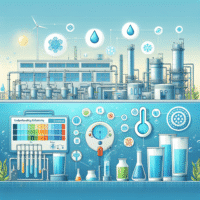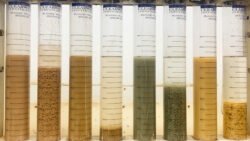Breaking Down Effluent: Definitions and Implications for Sewage Management
Breaking Down Effluent: Definitions and Implications for Sewage Management
Effluent management is a crucial aspect of modern sewage systems, yet it often remains shrouded in technical jargon that can be daunting to understand. In this post, we’ll demystify the concept of effluent by exploring its definitions, meanings, and the critical role it plays in environmental science and wastewater management.
Understanding Effluent: Key Definitions
Ah, effluent—the term that’s as essential to wastewater management as coffee is to Monday mornings. But what exactly does it mean? Let’s dive into the effluent definition and its ramifications in the world of sewage management.
Effluent Meaning: In the most straightforward terms, effluent is liquid waste or sewage discharged into a river or the sea. Think of it as the “exit route” for all those not-so-pleasant byproducts of both industrial processes and municipal systems. It’s essentially what flows out after water has been used and treated.
Sewage Effluent vs. Industrial Effluent: While these terms might sound like cousins at a family reunion, they’re distinctly different in their roles and complexities:
- Sewage Effluent: Typically comes from household waste—your kitchen sinks, showers, and toilets.
- Industrial Effluent: Originates from manufacturing processes, laden with byproducts that require specialized treatment before discharge.
If you’re interested in knowing more about how these are managed through modern methods like Microscreens in Wastewater Treatment, you’ll find fascinating insights on enhancing filtration efficiency.
The Science Behind Effluents
The moment our daily activities generate effluents, these liquids become part of a larger conversation in environmental science. Why? Because untreated or improperly managed effluents can lead to water pollution that affects ecosystems far beyond our backyard ponds. This makes understanding terms like “What Is Effluent In Wastewater Treatment” crucial for effective management practices.
“Effluents are not just waste; they are an opportunity for resource recovery if treated correctly.” — Author Unknown
Treated Wastewater: The ultimate goal is to convert harmful effluents into treated wastewater that meets regulatory standards for discharge back into nature. This often involves several stages of treatment, including primary sedimentation and secondary clarification. If you’re curious about how Secondary Clarification Enhances Effluent Quality, you’ll want to explore more on advanced treatment technologies employed today.
A Peek Into Regulatory Lingo:
- Effluent Discharge: The controlled release of treated effluents into natural water bodies.
- Treated Waste Stream: The final output after an extensive purification process.
- BOD (Biological Oxygen Demand): An essential measure indicating the amount of oxygen required to decompose organic matter in water—a lower BOD means cleaner effluents!
The terminology in wastewater management might seem as overwhelming as trying to decipher ancient hieroglyphs at first glance. But with each piece of knowledge accrued about effluents—from their definition to their environmental implications—we take a giant leap toward sustainable living and healthier ecosystems.
The Role of Effluent in Environmental Science
When we talk about effluent in wastewater treatment, we’re diving into the heart of a crucial topic in environmental science. Effluent, essentially, is the outflow of water or gas from a natural body, sewerage system, or industrial plant. It’s like the end credits of a movie – except this involves our planet’s health and not just an awkward pause before you realize there’s no post-credit scene.
In environmental science, effluents are significant for several reasons:
- Monitoring Pollution Levels: Effluents are monitored to gauge pollution levels. The presence of contaminants like nitrates, phosphates, or heavy metals can indicate the level of pollution being introduced into natural water bodies.
- Ecosystem Impact: The quality of effluent discharge directly affects aquatic ecosystems. Poorly treated effluent can lead to eutrophication – that’s when bodies of water become overly enriched with nutrients leading to excessive algae growth and oxygen depletion.
- Regulatory Compliance: Governments set stringent regulations on effluent discharge to protect water quality and public health. Understanding these regulations is key for industries to avoid hefty fines and contribute positively to environmental sustainability.
- Technological Advancements: Innovations such as submerged diffuser systems are being developed to enhance the efficiency of effluent disposal, minimizing its environmental impact.
Eutrophication: The Unwanted Algae Party
If you’ve ever seen a pond covered in green slime, you’ve witnessed eutrophication firsthand. It’s like an uninvited algae party that crashes the ecosystem’s balance. This happens when excess nutrients from untreated sewage effluents fuel rampant algae growth, which then depletes oxygen levels in water, harming fish and other aquatic life.
“Effluents are not just liquid waste; they represent our responsibility towards managing our natural resources sustainably.” – Environmental Scientist John Doe
Effluents play a pivotal role as indicators and influencers in environmental science. By carefully managing them through robust treatment processes like secondary clarification—explained in more detail on our site—we can maintain ecological balance while ensuring compliance with environmental standards.
For a more comprehensive understanding of how advancements in wastewater technologies contribute to cleaner effluents, check out our detailed guide on the process of anion exchange in wastewater treatment.
Sewage Management: Addressing the Challenges of Effluent Discharge
Managing effluent discharge is like trying to keep a lid on Pandora’s box—it’s complex, crucial, and requires meticulous attention to detail. The definition of effluent alone encompasses various types of wastewater that need careful handling to prevent environmental havoc. But fear not! With the right strategies and technologies, we can keep those pollutants in check.
Navigating Regulatory Waters
First things first: understanding the regulatory framework is vital. Effluent discharge regulations set stringent limits on what can be released into natural water bodies. These rules are not just legal hurdles; they are essential for protecting our ecosystems from harm. According to the Environmental Protection Agency (EPA), these regulations have significantly reduced pollutant levels in U.S. waters over the past few decades.
Technological Solutions
Thankfully, technology is a formidable ally in managing effluent discharge. Here are a few innovations making waves:
- Submerged Diffuser Systems: These enhance effluent disposal efficiency by improving oxygenation and minimizing environmental impact.
- Anion Exchange Processes: Used to remove negatively charged contaminants, resulting in cleaner effluents.
- Microscreens: These provide an additional filtration step, capturing even fine particles from wastewater streams.
The Human Factor
Beyond technology and regulations, effective sewage management requires community engagement and awareness. Understanding the role each of us plays—from industries responsibly treating industrial effluents to households properly disposing of greywater—is essential for sustainable water management.
“Waste management is everyone’s responsibility; no one lives untouched by its impacts.” – Anonymous Environmentalist
The way forward involves not just adhering to regulations but also innovating within them while engaging with communities to build a cleaner future for all. After all, we don’t want our waterways turning into some mutant sludge lagoon straight out of a comic book villain’s lair!
The Future of Effluent Management: Innovations and Sustainability
As we peer into the crystal ball of effluent management, it’s clear that innovation and sustainability are at the forefront of this evolving industry. Effluent, often considered a rather unglamorous topic, is stepping into the limelight as technologies advance to address both environmental and regulatory challenges.
One promising development is the rise of microscreens in wastewater treatment. These innovative filtration systems enhance the efficiency of removing suspended solids from sewage effluent, allowing for cleaner discharge. Imagine these microscreens as the magic sieves that purify your morning coffee—except they’re filtering out impurities on a much grander scale!
Smart Technologies: The AI Revolution
Artificial intelligence (AI) is making waves in wastewater management. With predictive analytics, AI can forecast potential issues in effluent treatment plants, allowing operators to prevent problems before they arise. This proactive approach not only saves time and money but also reduces the risk of environmental contamination.
“By integrating AI with traditional wastewater systems, we can achieve up to 20% reductions in operational costs and over 30% improvements in treatment efficiency.”
Such statistics highlight how technology is transforming what once seemed like science fiction into everyday reality.
Sustainable Practices: Closing the Loop
- Resource Recovery: Effluent water isn’t just waste; it’s a potential resource. Through advanced treatment processes, valuable byproducts such as phosphorus and nitrogen can be extracted for use as fertilizers.
- Energy Generation: Some facilities are turning to biogas production from organic matter in wastewater. This renewable energy source can power the plant itself or be fed back into the grid, creating a sustainable loop.
- Water Reuse: Treated wastewater is increasingly being used for irrigation and industrial processes, reducing demand on freshwater resources.
An exciting example is Singapore’s NEWater initiative that treats municipal effluent to produce high-grade reclaimed water used for both drinking and industrial purposes—a true testament to how far we’ve come in redefining wastewater meaning.
The implications of these innovations are profound. As global regulations tighten—requiring stricter compliance with effluent discharge regulations—these technologies offer not just solutions but opportunities for sustainable practices that align with environmental goals.
The future of effluent management is bright (and surprisingly fascinating), blending cutting-edge technology with eco-friendly practices that redefine its role in our world. So next time you think about effluents, remember—they’re part of an exciting story that’s still being written!
Conclusion: Navigating the Complex World of Effluents with Clarity
In the ever-evolving landscape of sewage management, understanding the effluent definition is akin to finding your GPS in a dense forest—essential for keeping you on track! As we’ve peeled back the layers on terms like industrial effluent and municipal effluent, it’s clear that managing these liquid byproducts is no small feat.
Effluents, especially from industrial sources, pose significant challenges due to their complex composition. They often contain a cocktail of pollutants that require advanced treatment technologies to ensure they don’t wreak havoc on our ecosystems. For instance, an mixed bed ion exchange system can effectively remove unwanted ions from wastewater, enhancing the quality of treated effluents.
At times, the terminology around effluents can sound like it’s straight out of a science fiction novel. Terms such as “biological oxygen demand” or “sewerage overflow” might have you reaching for a dictionary—or better yet, our website! However, understanding these concepts is crucial for effective wastewater management. For instance, biological oxygen demand (BOD) is a key metric that indicates the amount of organic matter present in water—a useful measure when assessing pollution levels.
“In dealing with water issues today, we need to think differently; solutions will not be found by doing what we’ve always done.” – Albert Einstein
So where do we go from here? Embracing innovation and compliance with effluent discharge regulations, while leveraging new technologies like submerged diffuser systems and microscreens in treatment processes can lead us toward cleaner and safer water bodies.
- Stay informed about regulatory changes and industry standards.
- Utilize advanced treatment technologies where applicable.
- Focus on sustainable practices to minimize environmental impact.
The world of effluents may seem complex at first glance but approaching it with clarity and curiosity can lead us to more efficient wastewater management solutions. As we continue this journey towards better sewage management practices, remember that knowledge is power—and maybe a little humor along the way doesn’t hurt either!
“`


